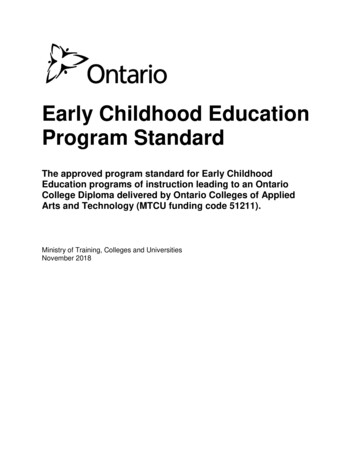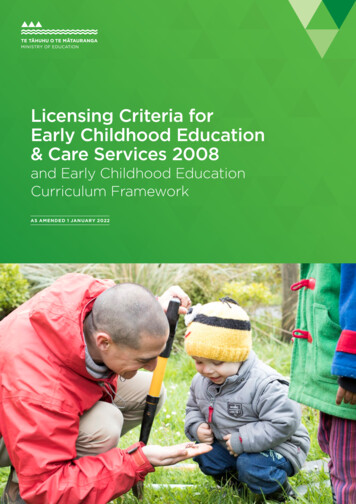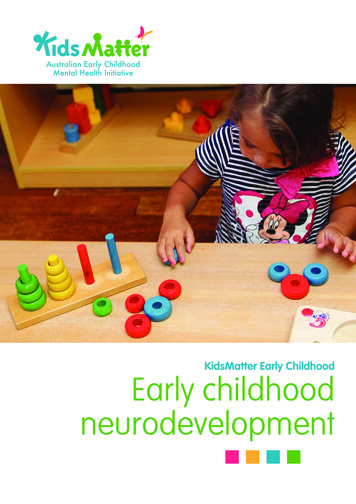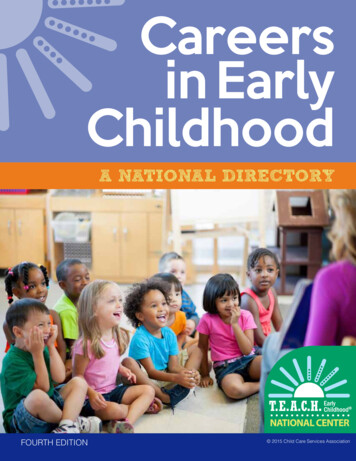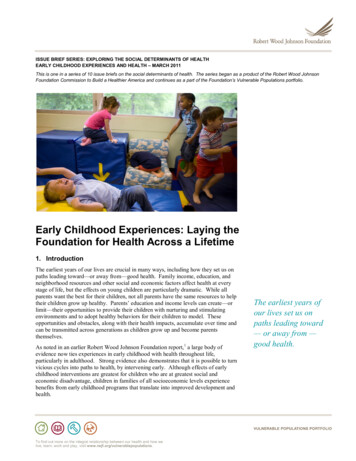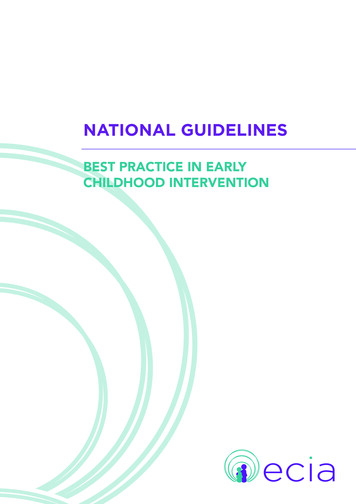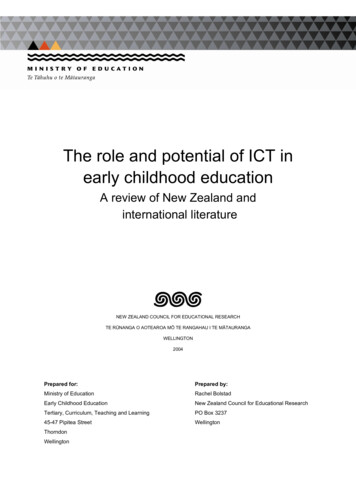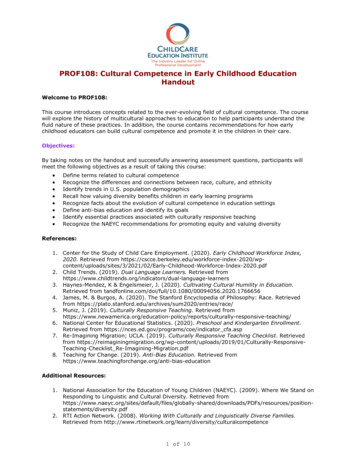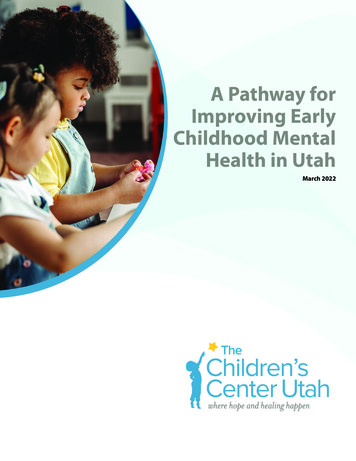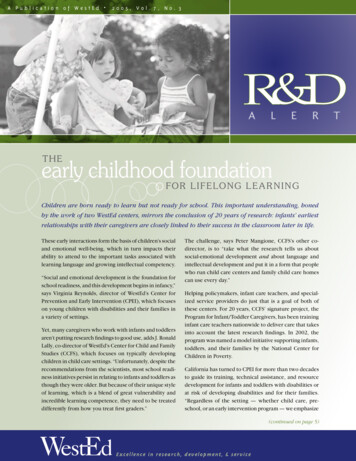
Transcription
A Publication of WestEd 2005, Vol. 7, No. 3THEearly childhood foundationFOR L IF ELONG L E A R NINGChildren are born ready to learn but not ready for school. This important understanding, honedby the work of two WestEd centers, mirrors the conclusion of 20 years of research: infants’ earliestrelationships with their caregivers are closely linked to their success in the classroom later in life.These early interactions form the basis of children’s socialand emotional well-being, which in turn impacts theirability to attend to the important tasks associated withlearning language and growing intellectual competency.“Social and emotional development is the foundation forschool readiness, and this development begins in infancy,”says Virginia Reynolds, director of WestEd’s Center forPrevention and Early Intervention (CPEI), which focuseson young children with disabilities and their families ina variety of settings.Yet, many caregivers who work with infants and toddlersaren’t putting research findings to good use, adds J. RonaldLally, co-director of WestEd’s Center for Child and FamilyStudies (CCFS), which focuses on typically developingchildren in child care settings. “Unfortunately, despite therecommendations from the scientists, most school readiness initiatives persist in relating to infants and toddlers asthough they were older. But because of their unique styleof learning, which is a blend of great vulnerability andincredible learning competence, they need to be treateddifferently from how you treat first graders.”The challenge, says Peter Mangione, CCFS’s other codirector, is to “take what the research tells us aboutsocial-emotional development and about language andintellectual development and put it in a form that peoplewho run child care centers and family child care homescan use every day.”Helping policymakers, infant care teachers, and specialized service providers do just that is a goal of both ofthese centers. For 20 years, CCFS’ signature project, theProgram for Infant/Toddler Caregivers, has been traininginfant care teachers nationwide to deliver care that takesinto account the latest research findings. In 2002, theprogram was named a model initiative supporting infants,toddlers, and their families by the National Center forChildren in Poverty.California has turned to CPEI for more than two decadesto guide its training, technical assistance, and resourcedevelopment for infants and toddlers with disabilities orat risk of developing disabilities and for their families.“Regardless of the setting — whether child care, preschool, or an early intervention program — we emphasize(continued on page 5)WestEdExcellence in research, development, & service 1
Improving the lives of children requires much more than improving schools. If we want allchildren to succeed in school and beyond, we’ve got to start young. Very young.While the importance of early childhood education has long been recognized, traditionalideas of “school readiness” may be outdated. The first years of life are uniquely important interms of what children need in order to learn, grow, and thrive, not just in setting the stagefor how children will fare in school.F O C U S I N GO NEarly Childhood EducationF R O MT H ECEOThe best way for adults to support infants is not necessarily by focusing on the more“academic” areas of literacy and numeracy that will become important later. Instead, asthe lead article in this issue of R&D Alert suggests, adult caregivers would do better tofocus primarily on what the children are interested in, while providing encouragement,enhancement, and social and emotional support.Drawing on early childhood research and the work of two WestEd programs — the Center forChild and Families Studies (CCFS) and the Center for Prevention and Early Intervention (CPEI)— the article describes the kinds of support and experiences that best help address the uniquedevelopmental needs of infants and young children.A second article, drawn from an upcoming book on “Bridging Cultures,” addresses howculture and child-rearing are closely intertwined. The article outlines two broadly different cultural perspectives that provide a framework to help teachers and caregivers supportchildren’s transitions between home to child care settings.Another article looks at the benefits of high-quality early childhood education from aneconomic perspective. It reports on a WestEd paper in which economist Robert G. Lynchmakes a compelling case for large-scale investment in an early childhood developmentprogram. By focusing especially on children living in poverty, such a program can lead toenormous benefits for children, including improved graduation rates and decreased risk oftrouble with drugs, alcohol, and crime. Lynch notes that these outcomes also provide significant economic benefits for society as a whole.WestEd’s expertise in early childhood education goes far beyond what we can share in thespace of this newsletter, so we encourage you to follow up by using the contact informationincluded with each article and by visiting WestEd.org. Whether you work in a school setting,in higher education, as a policymaker, or elsewhere, strengthening programs for children intheir earliest years should be everyone’s business.Glen HarveyChief Executive Officer 2 R&D AlertB
Why should early childhood professionals consider the role of culture? Increas-ingly, home- and center-based staff and providers work with children and families whocome from cultural backgrounds different from their own. Early care and education programsare generally the first settings where children may be away from their families for extendedperiods of time.Most families with children have more contact with early childhood professionals than theydo with educators once their children enter elementary school and start moving up the grades.This first contact is especially important because it helps form families’ attitudes toward school,educators, and other child-serving professionals. Thus, the early childhood years provide caregivers and early educators an opportunity to make a positive impact not only on children’sadjustment to outside care and education but also on long-term relationships between familiesand professionals.Bridging CulturesIN EARLY CHILDHOODEarly childhood is a critical time to begin establishing common ground between teachers (including infant-toddler caregivers and other professionals) and the children andfamilies they serve.This article is an excerpt from Bridging Culturesin Early Care and Education: A Training Module,a resource to help pre-service and in-serviceAN ORGANIZING FRAMEWORK FOR UNDERSTANDING CULTUREearly childhood educators, including infant-Bridging Cultures in Early Care and Education: A Training Module introduces how earlychildhood educators can use the organizing concepts of individualism and collectivism asa means of understanding cultural differences between themselves and the families theyserve. These concepts have been shown to be accessible and highly useful in improvinghome-school understanding across cultures.toddler caregivers, understand the role of cultureThe framework describes the value systems of cultures in a nonjudgmental way. This makesit a safe way to begin learning about cultures — one’s own as well as those of others.Culture has many different definitions, but a simple one used in the Bridging Cultures in EarlyCare and Education (BC-ECE) module is “a set of values, beliefs and ways of thinking about theworld that influences everyday behavior” (Trumbull & Farr, 2005). Culture is transmitted from onegeneration to the next in multiple ways, both explicitly — in conversations and direct guidance— and implicitly — in daily practices such as child-rearing. It is when disparities in the valuesand belief systems of different individuals become evident that culture comes into focus.in their programs and in their interactions withparents. Developed with the support of WestEd,the A. L. Mailman Foundation, and the Foundation for Child Development, the training guide ispublished by Lawrence Erlbaum Associates anddue to be released in early 2006. The authors— Marlene Zepeda, Janet Gonzalez-Mena, CarrieRothstein-Fisch, and Elise Trumbull — caution thatthe cultural framework described here is a tool forunderstanding fundamental cultural differencesbut should not be used to oversimplify culturesor to categorize individuals.(continued on next page)WestEd 3
(continued from previous page)BC-ECE training helps teachers and child care providersbecome “cultural bridges” between children and familiesand early care and education settings.feeding, dressing), and use “their words” to identifytheir needs. All of these examples are signs that individualism is valued.The framework’s two basic concepts — individualismand collectivism — are used to illustrate how culturalbeliefs and values shape attitudes and behaviors. Eachorientation is associated with a different set of culturalpriorities that, among other things, guide how membersof a culture rear and educate their children. Focusingon this distinction is not the only way to think aboutcultural differences, but it has proven to be extremelyuseful for understanding many instances of crosscultural alism stresses independence and individualachievement, focusing on the needs of the individual,self-expression, and personal choice. It emphasizes the“object” world, particularly with respect to the conceptof private property and the idea that objects are a sourceWWhile the culture of the United States as a whole valuesand encourages individuals’ independence, most of theworld’s cultures tend to focus on the interdependenceof groups and individuals, reflecting the cultural valueof “collectivism.” According to cross-cultural experts, acollectivistic value orientation is found in 70 percent ofthe world’s cultures (Triandis, 1989).Collectivism emphasizes social responsibility and thepriority of group needs over individual needs. It stressesrespect for authority and obligation to group norms. Incollectivistic cultures, possessions are often shared,with objects being important in the context of humanrelationships, not in and of themselves. For instance,a toy or household object may be used as a source ofinteraction between a mother and child, but the childhile the culture of the United States as a whole values and encouragesindividuals’ independence, most of the world’s cultures tend to focus onthe inter dependence of groups and individuals, reflecting the culturalvalue of “collectivism.”of learning about the physical world. When a preschool,infant program, or family child care home operates primarily from an individualistic perspective, children aretreated as unique and special individuals who need theopportunity to explore objects in their surroundings andto learn to become independent.The physical environment is also likely to reflect thisperspective, with children having their own cubbies,lockers, or coat hooks identified as “theirs” and theirnames and pictures prominently displayed. It is alsolikely that parents are asked to put nametags on theirchild’s clothing. Children are encouraged to take careof their property, take care of themselves (e.g., toileting, 4 R&D Alertis not likely to be directed to play with it or investigateit independently. In this example, the object is viewedas a tool for emphasizing the relationship between themother and the child, one based on interdependence,helping, and sharing. In collectivistic cultures, there isalso a strong emphasis on the family as a unit, not oneach individual member per se.When a preschool, infant program, or family child carehome emphasizes sharing and downplays the individualand his or her personal accomplishments in favor of theachievements of the group, it is exhibiting collectivistic values. Collectivistic practices that can be seen inearly care and education settings include potluck mealsas a means of sharing across many families, favoring
(continued from page 1)large-group size for activities over small-group or individual interaction, and mixed-aged grouping where olderchildren help and assist the younger children.supporting and nurturing the healthy caregiverchild relationship to provide the foundation forsocial and emotional well-being,” says Reynolds.WE CAN BUILD CULTURAL BRIDGESTHE RESEARCH FINDINGSIs it possible to reconcile the differences between collectivism and individualism? Can early childhood educatorscreate links between those who are clearly collectivisticand those who are not? Can collectivistic families andchildren be made to feel at home in an individualisticenvironment and vice versa?Both centers are guided by research on early childhood development and early intervention, such asa notable study by the National Research Counciland the National Academies’ Institute of Medicinethat includes the following findings:The Bridging Cultures project is predicated on the belief that the answer to all of these questions is yes. Infact, many early childhood care and education settingsalready reflect a good balance between collectivism andindividualism. But they are rarer than they should be.BC-ECE training is designed to help participants developan appreciation for the contrasting patterns of care andeducation reflected in individualistic and collectivisticvalue orientations, to understand that these values neednot be mutually exclusive, and to explore how best tobridge and blend these two perspectives in early childhood and related settings.Trumbull, E. & Farr, B. (2005). Language and Learning:What Teachers Need to Know. Norwood, MA: Christopher-Gordon Publishers, Inc.Triandis, H. C. (1989). Cross-cultural studies of individualism and collectivism. Nebraska Symposium onMotivation, 37, 43-133. “Human development is shaped by a dynamicand continuous interaction between biologyand experience. The growth of self-regulation is a cornerstoneof early childhood development that cuts acrossall domains of behavior. Children are active participants in their own development, reflecting the intrinsic human driveto explore and master one’s environment. Human relationships, and the effects of relationships on relationships, are the building blocksof healthy human development.”1Lally points out that such findings carry significantimplications for those designing and implementingearly childhood programs. For example, he notesthat babies have an “inborn capacity and inclination” to learn particular things. So, infant learning“is more heavily influenced by the child’s internalagenda” than by external stimuli, he says.Likewise, consider the strong connection betweenhow infants and toddlers feel and how well theylearn. “In the early years, safety, survival, andsecurity are crucial,” says Lally. “That means thatbefore they can attend to intellectual pursuits,children need to link to people they trust and feelrelaxed around.”Reynolds agrees. “When a caring adult providesencouragement to infants and toddlers in their initial attempts to explore their environment, youngShonkoff, J. P., & Phillips, D. A. (eds.). (2000). From Neuronsto Neighborhoods: The Science of Early Childhood Development. Washington, D.C.: National Academy Press.1(continued on page 8)WestEd 5
Can FundingPreschoolTodayInvesting immediately in a national preschool program would yieldsignificantly strengthening our nation’s economy well into the future, says aIn “Early Childhood Investmentbenefit the children and families itwill place on the system. As adults,Yields Big Payoff,” economistwould serve. When children fromthey would enter the workforce atRobert G. Lynch writes that fund-low-income families are providedhigher skill levels, earning largering a national, high-quality, earlyaccess to high-quality preschool,salaries, and paying more taxeschildhoodpro-research shows they performinto the system.gram would help balance cash-much better in school, experiencestrapped government budgets byhigher graduation rates, and tenddevelopmentcreating year-over-year incremental savings. He notes that thefirst class of today’s preschoolerswould enter the workforce andbegin increasing its productivity at about the same time whensome experts project that thenation could face serious financial difficulties paying for SocialSecurity and other programs.By selecting all three- and fouryear-olds who fall below thepoverty line, Lynch’s proposednational 6 program would be substantial,alcohol, and crime.the payoff would be huge. In“From an investment point ofrity, such a publicly funded earlyview, the returns are greater thanchildhood development programif we invested the same amountis expected to have enormousof money in the stock market. It’spositive impacts on our society byaddition to helping Social Secu-an ingenious way for our tax dol-improving the quality of life forlars to beat average Wall Streetmillions of children and loweringreturns while benefiting societycrime rates. It also would benefitat the same time,” says Lynch.the U.S. economy by raising theLynch estimates the annual preschool cost per child at 12,000.If the national program weregross domestic product, helpingbalancegovernmentbudgets,and strengthening global competitiveness.programfully implemented next year, bywould enroll the very 1.6 millionthe time the first preschoolers en-In response to the report, J.youngsters who, as they growtered the workforce, they wouldRonaldup, would otherwise cost taxpay-contribute substantially to SocialWestEd’s Center for Child anders most. A national preschoolSecurity and help counteract theFamilyprogramdemands aging baby boomersthe importance of high-qualityR&D Alertpreschoolto stay out of trouble with drugs,Although the upfront costs of hasized
Reduce budget woesTomorrow?high returns,recent WestEd report.The Proposed National Preschool Program At-A-Glance» High-quality preschool enrollment for all low-income three- and four-year-olds» Affects 20% of all three- and four-year-olds nationwidepreschool. “As a society, wehave ignored too long the indisputable research demonstratingthe clear benefits of high-qualityout-of-home care for childrenfrom birth to age six. Now is thetime to act.”WestEd’s peer-reviewed reportfollows on the heels of a March2005 RAND study showing theeconomic benefits of a preschoolprogram for all children in thestate of California.“Early Childhood Investment YieldsBig Payoff” is available free ofcharge as a pdf file online:www.WestEd.org/earlyinvestment» Impacts 1.6 million children in the program’s first year» Every dollar spent generates 3.78 or more in benefits» Full implementation in 2006, running a surplus by 2021» By 2050, the budgetary surplus grows to 167 billionFast Facts About High-Quality Preschool: BenefitsExtend Throughout Life*IN ELEMENTARY SCHOOL:» Fewer criminal acts» Higher scores on math andreading tests» Lower rates of alcohol anddrug use» Greater language abilities» Lower incarceration rates» Less grade retention» Less need for special educationand remedial workIN ADULTHOOD:» Higher employment» Improved nutrition and health» Higher earning rates» Lower rates of child abuseand neglect» Increased tax baseIN MIDDLE AND HIGH SCHOOL:» Lower teen pregnancy andparenting rates» Lower dropout rates» Higher high school graduationrates» Higher scores on math andreading tests» Less dependence on welfare» Lower rates of alcohol anddrug use» Fewer criminal acts» Lower incarceration rates*Research references are includedin the full report:www.WestEd.org/earlyinvestmentWestEd 7
(continued from page 5)children learn they have someone torely upon, so they feel secure, andthus become more eager to try newthings,” she says. “With guidance,they learn to persist and experiencemastery. The lessons learned fromthese early interactions and relationships form the basic building blocksfor later learning.”recite the alphabet than they do withtheir ability to negotiate their emotions and relationships.”PUTTING THE RESEARCH TO USEBoth CCFS and CPEI disseminate information — through institutes, seminars, on-site training sessions, technical assistance, and materials such asvideos, guides, and manuals — aimedat increasing the practice of relationship-based care in all settings.Such relationships also help shape achild’s self-image, which is developedas early as two years of age. And theConsider these three CCFS projectsway young children view themselves,undertaken for the California Departsays Mangione, affects how well theyment of Education:learn. One goal of early childhoodeducation, he says, is to help children Infant/Toddler Learning and Develbecome “self-confident enough toopment Guidelines — a resource forthose running center-basedexplore and self-regulatedand family child careenough to function”Youhomes serving chilcan’ti n a cl a s sroom.dren from birthunderestimate“These crucialtheto age three thatcomponents ofimportance ohighlights keyfhonora child’s senseelements of exing the role oof s el f,” hef the familyemplary earlyadds, “comein the child’schildhoodlife. Familyfrom the wayprogramsmembers arehe or she isa child’s Infant/Todtreated in thebest and firstdlerL ear n i ngfirst three years.”teachers.St a nd a rd s — atool to help infantMarie Kannecare teachers understandPoulsen, a CPEI consulwhatlearning generally lookstant, notes that school success,likeatspecificages from birth totraditionally equated with academicage threeachievement, is more appropriatelypursued by focusing on “relation- The Desired Results Developmenships, resilience, and readiness” intal Profile for Infants and Toddlers—an assessment tool that helpsearly childhood. These skills can beinfantcare teachers determinedeveloped long before a child entersthe developmental progress ofthe classroom. “When children showindividual childrenup for kindergarten, they are expected to sit still and focus, express their “As infant care teachers use thesefeelings, and get along with others,” kinds of resources to learn aboutPoulsen says. “However, these tasks children’s developmental stageshave less to do with their ability to and the emotional foundations of 8 R&D Alertlearning,” says CCFS’s Lally, “we seethem giving a higher quality of care.”According to Cathy Tsao, CCFS’ director of national and internationaltraining, the guidelines call on infantcare teachers to develop strong, positive partnerships with families. “Youcan’t underestimate the importanceof honoring the role of the family inthe child’s life,” says Tsao. “Familymembers are a child’s best and firstteachers.” Thus, it’s critical, she says,that decisions about children aremade only after “engaging familiesin a true dialogue and taking into account how they want things done.”Only when families believe the infantcare teacher really understands themand their child will they be willingto accept the teacher’s advice andrecommendations.The guidelines also point out theneed for infant care teachers torespond simultaneously to both theemotional and intellectual needs ofa child. “Some think all you needis tender, loving care, while on theother extreme the goal becomesinfant stimulation — all flashcardsand Mozart,” says Tsao. “We need toremember that young children needto have their emotional and intellectual needs met.”MEETING SPECIAL NEEDSIn the case of children with disabilities, says CPEI’s Reynolds, “Achieving social and emotional wellnessbegins with the same foundation asfor typically developing children,but it also necessitates the use of individualized supports and strategiesthat specifically address the child’sspecial needs. Linking families tohigh-quality support services cango a long way.”
CPEI works closely with the California Three CPEI projects that focus on soDepartment of Developmental Services, cial and emotional development are:the agency responsible for implement The Infant, Preschool, and Familying the Early Intervention ProgramMental Health Initiative — a collab(Part C) of the federal Individualsorative of interagency teams fromwith Disabilities Education Act. Theeight California counties workchallenge, says Reynolds, is to ensureing together to providethat service providers notrelationship-basedonly meet the requireearly intervenments of IDEA, buttion for chilInfant carealso do so in a waydren fromtothat takes into acteachers needbir th toyslcount researchuoenltaage five,respond simufindings on theincludotionali mpor tance ofto both the eming thoseedsenrelationshiplatuwithdisclleteand inbased services.abilities.of a child.Reynolds notes thatachieving emotionaland social wellness is different for an infant or child witha disability and the primary caregiver. “It adds a whole different dimension,” she says. Take, for example,children born blind or with cerebralpalsy who cannot make eye contactwith or hug their mothers. “Theseare critical behaviors that mothers,babies and toddlers engage in as away of establishing relationships,”says Reynolds. “If a child is unableto make eye contact or if a babycan’t hug his mother, it opens upthe possibility of the mother feelingunloved or unfit. Left unattended,this lack of typical behaviors that leta mother know she’s okay may leadto relationship difficulties. We knowfrom the research that we need toprovide support in these situationsand teach mothers, as well as othercaregivers and service providers, alternative strategies and techniquesthat can build strong social andemotional relationships.”The initiative developedpersonnel competencies and training guidelines for people whowork with children and families,including early interventionistsand mental health providers.To be sure, all of CPEI’s work is infused with the concepts of healthysocial and emotional developmentof children with disabilities andtheir families for many reasons. Butthe work is predicated on the notionthat early intervention is criticalif all children are to achieve theirfull potential. “By creating caringrelationships, understanding whychildren are acting the way theydo, and responding appropriately,”says Reynolds, “we help optimizetheir resilience, develop readinessfor school, and support families inensuring competency in all aspectsof their lives.”For more information: on CCFS, contact J. Ronald Lally at415.289.2300 or rlally@WestEd.org;Peter Mangione at 415.289.2310 orpmangio@WestEd.org; Catherine Tsaoat 415.289.2328 or ctsao@WestEd.org;or visit www.WestEd.org/ccfs on CPEI, contact Virginia Reynolds at916.492.4017 or vreynol@WestEd.org;or visit www.WestEd.org/cpei Project Relationship — a facilitated, relationship-based problemsolving framework to help localteams work together to meet theneeds of all children and families in their communities. All of Us Together Movingto Inclusion Institutes— events that bringrepresentatives of local agencies, schooldistr icts, and communities together forthree intensive days oftraining to increase theability of local communities to serve children withdisabilities in child care andpreschool settings.WestEd 9
Full-Day Kindergarten: Expanding LearningOpportunities(Policy Brief)(WestEd, 2005)As districts acrossthe country focuson c lo s i ng t heachievement gapbetween differents o c i o e co n o m i cand ethnic groups, research points to earlychildhood as a potent time for preventing the gapbefore it becomes established. Many policymakersare turning to an extended kindergarten programas part of the solution. This brief summarizes themost recent research on full-day kindergarten,provides information on state and local reformefforts, and identifies policy implications. It alsotouches on the characteristics of an effectivekindergarten program.4 pages / Price: Single copy, free / Order #: PO-05-01LNurturing theNurturers: TheImportance ofSound Relationships in EarlyChildhoodInterventionBonnie Benard &Douglas Quiett(WestEd, 2002)In the Marin CityFamilies First earlyintervention model, a home visitor plays a sweeping role in the life of the client family. The job isparticularly challenging for those working withfamilies in which financial uncertainty, substanceabuse, feelings of oppression, inadequate education, and other poverty-related factors can breeddepression, anger, and hopelessness. To becomeand remain effective, home visitors need a highdegree of support. This report describes howhome visitors support client families and how,in turn, home visitors receive support from theprogram supervisor.22 pages / Price: 8.95 / Order #: CCFS-03-01L /ISBN: 0-914409-09-3Caring for Infants and Toddlers in Groups: Developmentally Appropriate Practice, 2003 EditionJ. Ronald Lally, Abbey Griffin, Emily Fenichel, Marilyn Segal,Eleanor Szanton, & Bernice Weissbourd(Zero to Three Press, 2004)Caring for Infants and Toddlers in Groups is designed tohelp caregivers, program directors, coordinators, administrators, trainers, licensors, families, and leaders in the fieldof early childhood care and education recognize the specialknowledge and skills needed to offer a nurturing groupcare environment to very young children. Contributors, ledby WestEd’s Ron Lally, discuss meeting the needs of eachindividual child, recognizing early developmental stages, achieving necessary healthand safety standards, creating good relationships, developing training and mentoringprograms, linking with other community-based service systems, providing continuity ofcare, and being sensitive to cultural and linguistic needs.88 pages / Price: 18.50 / Order #: CCFS-03-03L / ISBN: 0-943657-67-9ResourcesWestEdO N E A R LY C H I L D H O O DWestEd has a number of resources addressing early childhood. A few aresummarized here. For additional related products, please refer to the WestEdResource Catalog or visit www.WestEd.org/products.Battered Agencies: Supporting Those Who ServeLow-Income CommunitiesDiane F. Reed, J. Ronald Lally, & Douglas Quiett (WestEd, 2003)This resea
Early Childhood Education This article is an excerpt from Bridging Cultures in Early Care and Education: A Training Module, a resource to help pre-service and in-service early childhood educators, including infant- toddler caregivers, understand the role of culture in their programs and in their interactions with parents.


